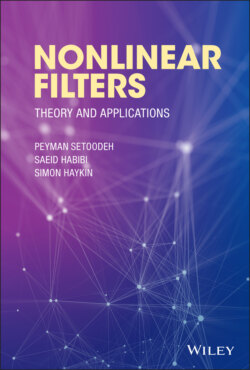Читать книгу Nonlinear Filters - Simon Haykin - Страница 29
2.7 Observability of Stochastic Systems
ОглавлениеBefore proceeding with defining observability for stochastic systems, we need to recall a few concepts from information theory [26]:
Definition 2.3 Entropy is a measure of our uncertainty about an event in Shannon's information theory. Specifically, the entropy of a discrete random vector with alphabet is defined as:
(2.95)
and correspondingly, for a continuous random vector , we have:
(2.96)
Entropy can also be interpreted as the expected value of the term :
(2.97)
where is the expectation operator and is the probability density function (PDF) of . Definition of Shannon's entropy, , shows that it is a function of the corresponding PDF. It will be insightful to examine the way that this information measure is affected by the shape of the PDF. A relatively broad and flat PDF, which is associated with lack of predictability, has high entropy. On the other hand, if the PDF is relatively narrow and has sharp slopes around a specific value of , which is associated with bias toward that particular value of , then the PDF has low entropy. A rearrangement of the tuples may change the shape of the PDF curve significantly but it does not affect the value of the summation or integral in (2.95) or (2.96), because summation and integration can be calculated in any order. Since is not affected by local changes in the PDF curve, it can be considered as a global measure of the behavior of the corresponding PDF [27].
Definition 2.4 Joint entropy is defined for a pair of random vectors based on their joint distribution as:
(2.98)
Definition 2.5 Conditional entropy is defined as the entropy of a random variable (state vector) conditional on the knowledge of another random variable (measurement vector):
(2.99)
It can also be expressed as:
(2.100)
Definition 2.6 Mutual information between two random variables is a measure of the amount of information that one contains about the other. It can also be interpreted as the reduction in the uncertainty about one random variable due to knowledge about the other one. Mathematically it is defined as:
(2.101)
Substituting for from (2.99) into the aforementioned equation, we will have:
(2.102)
Therefore, mutual information is symmetric with respect to and . It can also be viewed as a measure of dependence between the two random vectors. Mutual information is nonnegative; being equal to zero, if and only if and are independent. The notion of observability for stochastic systems can be defined based on the concept of mutual information.
Definition 2.7 (Stochastic observability) The random vector (state) is unobservable from the random vector (measurement), if they are independent or equivalently . Otherwise, is observable from .
Since mutual information is nonnegative, (2.101) leads to the following conclusion: if either or , then is observable from [28].
